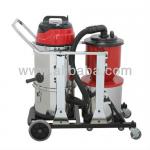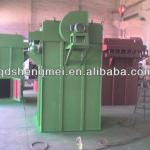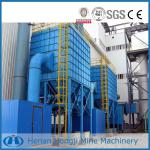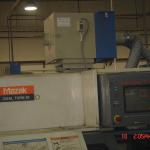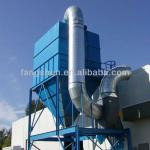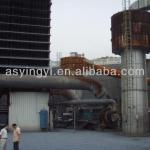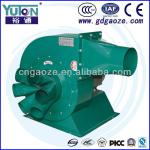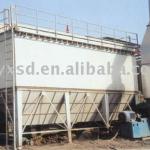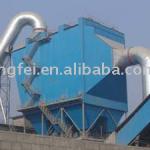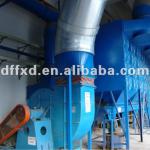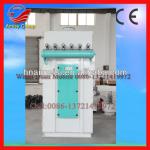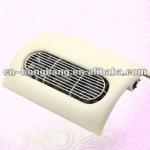filters--electrostatic precipitator
| Type:ESP Dust Collector | Place of Origin:Zhejiang China (Mainland) | Function:Dust Collector | Structure:Filtering Machine |
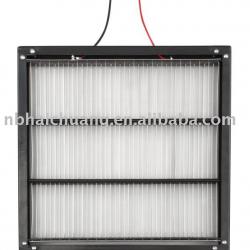
How Electrostatic Filtration Works
Electrostatic dust collectors use electrostatic charges to separate dust from the dusty air stream. A number of high voltage, direct current electrodes (carrying negative charge) are placed between grounded electrodes (carrying positive charge). The dust borne air stream is passed through the passage between the discharging (negative) electrodes and collecting (positive) electrodes. Dust particles receive a negative charge from the discharging electrodes (ionizing section) and are attracted to the positively charged grounded electrode (collection plates) and fasten on to it. Cleaning is done by rapping or vibrating the collecting electrode wherein dust particles fall away. Cleaning can be done without interrupting the flow.
For more thorough cleaning, the collection cell can be removed and washed by hand or in a parts washer with an aluminum safe detergent. Some ESP air cleaners have automatic self washing mechanisms.
| DUST COLLECTOR EXPERT TIP: Most common filtration is best used for ambient capture of light atmospheric dust. Unless you are using a self cleaning electrostatic precipitator, source capture or direct ducting from a heavy dust producing machine will quickly fill up the collection plates. Heavy dust collection requires storage for a large volume of dust. Surface area of pleated media filters, fabric bags or pleated cartridge media is much greater than surface area of electrostatic collection plates and work better for source capture and direct machine ducted than ESP would. |
The basic components of an electrostatic precipitator are (i) power supply unit (to impart high voltage, uni- directional current) (ii) an ionizing section where charge is imparted to dust filled air stream (iii) cleaning system to remove dust particles and (iv) housing for the precipitator.
ESP Advantages
Electrostatic precipitators have the following advantages:
- They have high efficiencies (exceeds 99.9% in some applications)
- Fine dust particles are collected efficiently
- Can function at high temperatures (as high as 700 degree F 1300 degree F)
- Pressure and temperature changes are small
- Difficult material like acid and tars can be collected
- They withstand extremely corrosive material
- Low power requirement for cleaning
- Dry dust is collected making recovery of lost product easy
- Large flow rates are possible
ESP Disadvantages
- High initial cost
- Materials with very high or low resistivity are difficult to collect
- Inefficiencies could arise in the system due to variable condition of airflow (though automatic voltage control improves collector efficiency)
- They can be larger than baghouses (fabric collectors) and cartridge units, and can occupy greater space
- Material in gaseous phase cannot be removed by electrostatic method
- Dust loads may be needed to be reduced before precipitation process (precleaner may be needed)
The efficiency of electrostatic precipitators can be increased by:
(i) larger collection surface areas and lower air flow rates give more time and area for dust particles to collect
(ii) increased speed of dust particles towards collection electrodes
Variation in Electrostatic Dust Collection Technology
Electrostatic precipitators are either single stage precipitators (high voltage) or two stage precipitators (low voltage).
Single Stage Precipitator
Single stage precipitators are of two types (i) Plate precipitators or (ii) Tubular precipitators.
Plate Precipitators
Single stage plate precipitators consist of a number of grounded plates (collecting plates), suspended parallel to one another with equal spacing between them (4-6 inch) and high voltage discharge (4000-6000 volts) electrodes that are suspended vertically between the plates from an insulated mounting frame. The discharge voltage causes the air stream to ionize and dust particles are negatively charged. As the negatively charged dust particles pass along the positively charged collection plates, they adhere to them. The collecting electrode is cleaned, and dust particles are collected in a hopper.
Design Considerations
- Efficiency is affected by the speed of the air stream. It is important to maintain even velocity distribution through precipitator from side to side and from top to bottom
- Care must be taken in design of distribution baffles
- Discharge electrodes are either hanging wires with weights or fixed frames. Hanging wires are economical.
- The closer the electrodes are to grounding plates, the more effective the charging forces are at lower voltage
Factors That Affect Efficiency
Some factors that could affect the efficiency of the electrostatic precipitator are as follows:
- Other gases in the air stream could affect efficiency
- Some dusts have high charge and greater forces may be required to attract them to the collection plates
- Sulfur compounds in boiler gas increase collector efficiency
- Pressure drop usually in the range of 0.2 to 0.5 inches

| Packaging Detail:standard export packing |
| Delivery Detail:within 10-15 working days after payment |



